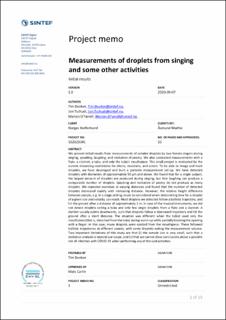| dc.description.abstract | We present initial results from measurements of exhaled droplets by two female singers during singing, speaking, laughing, and recitation of poetry. We also conducted measurements with a flute, a clarinet, a tuba, and only the tuba's mouthpiece. This small project is motivated by the current distancing restrictions for choirs, musicians, and actors. To be able to image and track droplets, we have developed and built a portable measurement set-up. We have detected droplets with diameters of approximately 50 μm and above. We found that for a single subject, the largest amount of droplets are produced during singing, but that laughing can produce a comparable number of droplets. Speaking and recitation of poetry do not produce as many droplets. We repeated exercises at varying distances and found that the number of detected droplets decreased rapidly with increasing distance. However, the relative height difference between people, e.g. in a stage setting, must be considered when determining how far a droplet of a given size and velocity can reach. Most droplets we detected follow a ballistic trajectory, and hit the ground after a distance of approximately 1 m. In case of the musical instruments, we did not detect droplets exiting a tuba and only few single droplets from a flute and a clarinet. A clarinet usually points downwards, such that droplets follow a downward trajectory and hit the ground after a short distance. The situation was different when the tubist used only the mouthpiece (that is, detached from the tuba) during warm-up while partially blocking the opening with a finger: in this case, many droplets were ejected from the mouthpiece. These followed ballistic trajectories at different speeds, with some droplets exiting the measurement volume. Two important limitations of this study are that (i) the sample size is very small, such that a statistical analysis is beyond our scope; and (ii) that we cannot draw conclusions about a possible risk of infection with COVID-19 when performing any of the said activities. | en_US |
